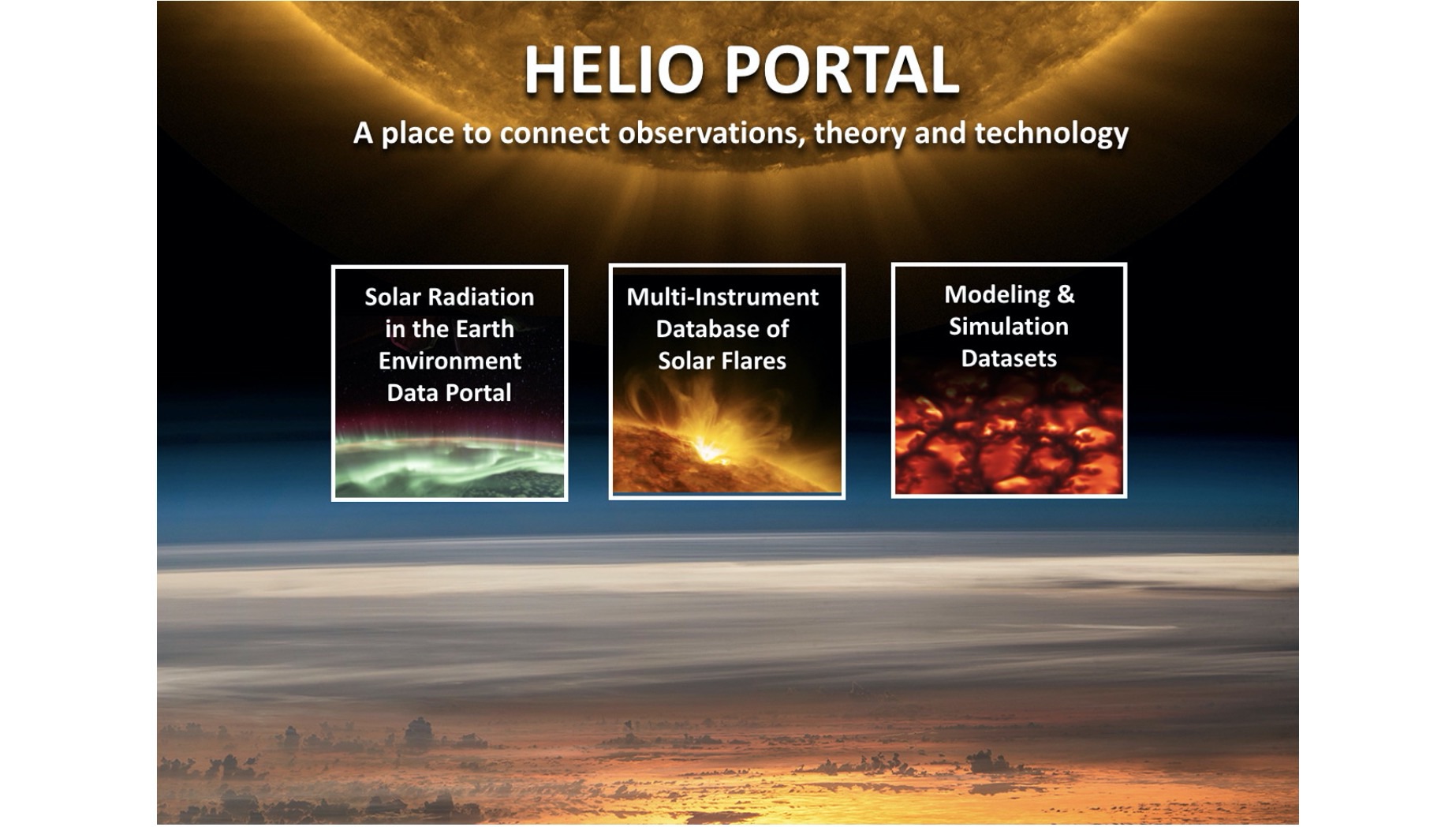The Data Portal is recovering from some unexpected issues with the underlying infrastructure used for data storage. We are working on incrementally reviving all datasets hosted on the portal. Return to operations with all hosted datasets online is early August. Any updates to this timeline will be posted on the site banner. We apologize for the inconvenience. If you have any questions or concerns, please contact support@nas.nasa.gov
Heliophysics Data Portal
High-fidelity modeling and simulation tools that enable research on the interiors and atmospheres of the Sun and other stars

Welcome to the Heliophysics Data Portal
For questions about this dataset, please contact the HMS Team.
| HMI Synthetic Data | Synthetic data for the solar disk center (0°), 30° and 60° latitudes of the FeI line (6173A), which corresponds to an operational wavelength of the Helioseismic and Magnetic Imager on board the NASA Solar Dynamics Observatory. (Data owner: Irina Kitiashvili) |
| 3D EULAG Global Models of Solar-Type Stars | 3D global models of solar-type stars for Rossby numbers 0.4 and 2. The results are published in Guerrero et al. (ApJ, 880:6, 2019, https://iopscience.iop.org/article/10.3847/1538-4357/ab224a) (Data owner: Gustavo Guerrero) |
| Spherical Convective Dynamo Models | The dataset provide the output of spherical convective dynamo simulations of solar-like stars with the Pencil Code for different rotation rates. (Data owner: Joern Warnecke) |
| Meridional Circulation Simulation | 1 FITS file (64 bit doubles) of a 60 hour simulation with 1 min time intervals (4000 time steps): MC_l200.fits; 5Gb, Mercator projected map of model surface, 2D mesh - 600 points in longitude, 300 points in latitude. (Data owner: Andrey Stejko) |
| GALE - Meridional Circulation | 3 FITS files (32 bit single precision) of 60 hour simulations with 1 min time intervals (4000 time steps), corresponding to models K1, M1 and M2 in Stejko et al.(2021) arXiv:2101.01220: K1_MC.fits, M1_MC.fits, M2_MC.fits; 2.7Gb, Mercator projected maps of model surface, 2D mesh - 600 points in longitude, 300 points in latitude. (Data owner: Andrey Stejko) |
| GALE - Meridional Circulation and Differential Rotation | 1 FITS file (32 bit single precision) of a 12.5 hour simulation with 1 min time intervals (750 time steps), Acoustic perturbations over a single-cell mean-field dynamo model M1 in Pipin & Kosovichev (2019): MC_DR_l300.fits; 1.2Gb, Mercator projected full disk map of model surface, 2D mesh - 900 points in longitude, 450 points in latitude. (Data owner: Andrey Stejko) |
| GALE - Synthetic Dopplergram Series of Differential Rotation | Synthetic Dopplergram data generated by the GALE code (Stejko et al. 2021; https://doi.org/10.3847/1538-4365/abd3fe)---a 3D Solar linearized acoustic code simulating the propagation of p-modes over user-specified background flows.
...
In order to analyze the detection of near-surface shear, we employ two 3D background profiles of differential rotation: the mean-field model M1 of Pipin et al. (2019; https://doi.org/10.3847/1538-4357/ab5952) and the non-linear convectively-driven model N5 of Matilsky et al. (2019; https://doi.org/10.3847/1538-4357/aaf647). The Gale code is actuated at a spectral resolution of lmax = 1000, for 8hr time-series at a cadence of 45s. In the top-level directory, the following two files contain the direct output of acoustic surface oscillations from the code sampled at 100 km above the simulated solar surface: GALE_t8h_l1000_M1.fits GALE_t8h_l1000_N5.fits These two FITS files contain outputs in rectangular grids with a resolution of lmax = 1000, corresponding to 3000 mesh points in phi and 1500 mesh points in theta. The meshgrids are attached inside the FITS files on the 2nd and 3rd Image HDUs. These outputs are subsequently remapped into helioprojective cartesian coordinates (aerial projection) into a 4096 x 4096 pixel image, simulating full-disk observations made by HMI/SDO, stored in the two following directories: HMI_M1 HMI_N5 These directories each contain 640 FITS files in the format of hmi.v_45s full-disk dopplergram data products from HMI, uncompressed, and with relevant keywords reflecting the new scale and viewing angle of the simulated images. (Data owner: Andrey Stejko) |
| Solar Flare Database | Rapid data search and classification of solar flares.
(Data owner: Irina Kitiashvili) |
| Radiation Data Portal | Measurements of the Earth's radiation environment from the Automated Radiation Measurements for Aerospace Safety (ARMAS) project.
(Data owner: Irina Kitiashvili) |
Quick Links
- News
- User Documentation
- myNAS User Portal
- System Status
- FAQ
- Get Accounts
- New User Orientation
- Training Webinars
Can't find what you're looking for? NAS User Support is available 24x7x365:
(800) 331-8737
(650) 604-4444
support@nas.nasa.gov